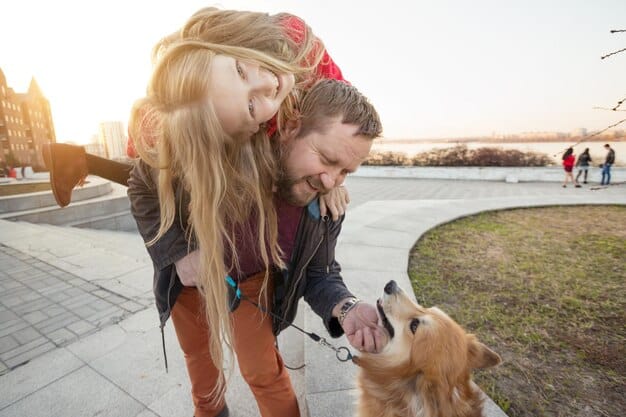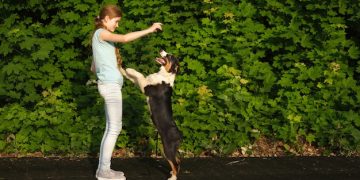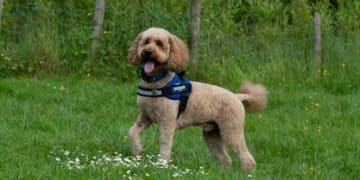Mastering Advanced Obedience: Off-Leash Control in Distracting Environments

Advanced obedience training focuses on achieving reliable off-leash control in environments with high levels of distraction, requiring a systematic approach to build focus, engagement, and impeccable recall.
Imagine the freedom of allowing your dog to explore off-leash, confident in their unwavering obedience, even amidst the chaos of a busy park or bustling street. Advanced obedience training: mastering off-leash control in high-distraction environments makes this dream a reality, transforming your dog into a well-mannered companion you can trust anywhere.
Understanding Advanced Obedience
Advanced obedience goes beyond basic commands like “sit,” “stay,” and “come”. It’s about cultivating a deeper connection with your dog, building a foundation of trust and respect that allows you to reliably control their behavior even when faced with tempting distractions. This level of training requires patience, consistency, and a thorough understanding of canine behavior.
It’s not just about suppressing unwanted behaviors but about channeling your dog’s energy and enthusiasm into positive actions. Think of it as creating a partnership where your dog *chooses* to obey, not because they’re forced to, but because they genuinely want to please you.
Key Elements of Advanced Obedience
Several key elements contribute to successful advanced obedience training. These include establishing clear communication, mastering the art of motivation, and creating a training environment that gradually increases the level of distraction.
- Clear Communication: Your dog needs to understand exactly what you expect from them. Use consistent verbal cues and body language to avoid confusion.
- Motivation and Rewards: Find what motivates your dog – treats, praise, toys – and use it strategically to reinforce desired behaviors.
- Gradual Progression: Start training in a quiet, controlled environment and gradually introduce distractions as your dog progresses.
- Consistency is Key: Reinforce commands regularly, even when you’re not actively training, to maintain a high level of obedience.
Ultimately, advanced obedience is about building a strong bond with your dog, creating a harmonious relationship based on mutual respect and understanding. It’s an investment that pays off with a well-behaved and happy companion you can enjoy anywhere.

Building a Solid Foundation
Before diving into off-leash training in distracting environments, it’s crucial to ensure your dog has a rock-solid foundation in basic obedience. This means they should reliably respond to commands like “sit,” “stay,” “come,” and “down” even in mildly distracting situations.
Think of basic obedience as the building blocks upon which advanced training is built. Without a strong foundation, trying to control your dog off-leash in a busy park is like trying to build a skyscraper on sand.
Essential Pre-requisite Commands
Several commands are absolutely essential before even considering off-leash work in high-distraction environments. Mastering these commands will set you and your dog up for success.
- Recall (Come): The most critical command. Your dog must come immediately and reliably when called, regardless of distractions.
- Stay: Your dog should be able to maintain a “stay” position for increasing periods of time, even with distractions present.
- Down: A reliable “down” command is useful for calming your dog in exciting situations and preventing unwanted behaviors.
- Leave It: This command teaches your dog to ignore tempting items or situations, preventing them from picking up dangerous objects or engaging in unwanted interactions.
Remember that patience and positive reinforcement are key when building this foundation. Focus on rewarding desired behaviors and avoid punishing mistakes. A strong foundation in basic obedience is the key to unlocking the freedom and enjoyment of off-leash control.
Gradual Exposure to Distractions
Once your dog has a solid foundation in basic obedience, the next step is to gradually introduce distractions into the training environment. This process should be systematic, starting with low-level distractions and gradually increasing the difficulty as your dog progresses.
Avoid throwing your dog into the deep end by immediately exposing them to a chaotic environment. Think of it as a controlled progression that allows them to build confidence and learn to focus on you even when tempting stimuli are present.
Creating a Distraction Hierarchy
A distraction hierarchy is a list of potential distractions, ranked from least to most challenging for your dog. This allows you to systematically introduce them into the training environment, ensuring your dog remains successful.
- Start with Low-Level Distractions: Begin with simple distractions, such as a person walking by at a distance or a quiet noise.
- Increase Intensity Gradually: As your dog becomes more confident, gradually increase the intensity of the distractions. This could include bringing the person closer, introducing louder noises, or adding more movement to the environment.
- Focus on Maintaining Control: The goal is to maintain your dog’s focus and obedience even with distractions present. If they start to break focus, reduce the intensity of the distraction and try again.
- Be Patient: Introducing distractions takes time and patience. Don’t get discouraged if your dog struggles at first. Just keep practicing and rewarding them for their successes.
By systematically introducing distractions, you can help your dog learn to focus on you and obey commands even in highly stimulating environments. This is a crucial step in mastering off-leash control.
The Power of Positive Reinforcement
Positive reinforcement is a training method that focuses on rewarding desired behaviors, making it more likely that your dog will repeat those behaviors in the future. This is a far more effective approach than using punishment or coercion, which can damage your relationship with your dog and lead to fear and anxiety.
Think of positive reinforcement as creating a win-win situation for both you and your dog. They learn that obeying commands leads to positive outcomes, while you get a well-behaved and happy companion.
Types of Positive Reinforcement
There are many different types of positive reinforcement you can use, depending on your dog’s preferences and the specific training situation.
Ultimately, positive reinforcement is about building a positive relationship with your dog based on trust and mutual respect. It’s a powerful tool that can help you achieve your advanced obedience goals.
- Food Rewards: High-value treats are a classic and effective form of positive reinforcement. Use small, tasty treats that your dog loves.
- Verbal Praise: Enthusiastic praise, such as “Good dog!” or “Yes!”, can be highly motivating for some dogs.
- Toys: If your dog is toy-motivated, use their favorite toys as rewards. This could include a tug-of-war game or a quick fetch session.
- Affection: Some dogs crave affection from their owners. A gentle pat or cuddle can be a powerful reward.
Experiment to find out what motivates your dog the most and use those rewards strategically during training. Remember to vary your rewards to keep your dog engaged and prevent them from becoming bored.
Troubleshooting Common Challenges
Even with careful planning and consistent training, you may encounter challenges along the way. It’s important to anticipate these challenges and have strategies in place to address them effectively.
Remember that setbacks are a normal part of the training process. Don’t get discouraged if your dog has a bad day. Just take a step back, reassess your approach, and try again.
Common Challenges and Solutions
Here are some common challenges owners face when training advanced obedience and strategies for overcoming them:
- Lack of Focus: If your dog is easily distracted, try reducing the intensity of the distractions or breaking the training session into shorter intervals.
- Ignoring Commands: If your dog is ignoring commands they previously knew, they suggest you’re moving too fast or the rewards are not motivating enough.
- Regression: Sometimes dogs will go. Be patient and go back to the basics.
- Frustration: If you or your dog are getting frustrated, end the training session and try again later. Training should be a positive experience for both of you.
By anticipating potential challenges and having strategies in place to address them, you can navigate the ups and downs of advanced obedience training with greater confidence. Remember that patience, consistency, and a positive attitude are key to success.

Maintaining Off-Leash Control
Achieving off-leash control is a significant accomplishment, but it’s important to remember that training is an ongoing process. To maintain your dog’s obedience in high-distraction environments, you need to continue reinforcing their training regularly and consistently.
Think of it like learning a new language. If you don’t practice regularly, you’ll eventually start to forget what you’ve learned. The same is true for your dog’s obedience.
- Regular Practice: Continue practicing commands regularly, even when you’re not actively training. This will help your dog maintain their skills and prevent them from forgetting what they’ve learned.
- Vary the Environment: Continue to expose your dog to different environments and distractions to ensure they remain obedient in a variety of situations.
- Be Consistent: Always enforce commands consistently and fairly. This will help your dog understand what you expect from them and maintain a high level of obedience.
- Stay Positive: Continue to use positive reinforcement to reward desired behaviors and maintain a positive relationship with your dog.
Maintaining off-leash control requires a commitment to ongoing training, but the rewards are well worth the effort. With consistent practice and a positive attitude, you can enjoy the freedom and companionship of a well-behaved dog you can trust anywhere.
| Key Point | Brief Description |
|---|---|
| 🎯 Foundation First | Master basic commands before advancing. |
| 📈 Gradual Exposure | Introduce distractions methodically. |
| 🐾 Positive Reinforcement | Reward good behavior consistently. |
| ⏳ Consistent Practice | Regular training keeps skills sharp. |
Frequently Asked Questions
▼
Generally, after your dog has mastered basic commands, usually around 1 year old, you can start advanced training. However, it varies per dog, so base it on individual readiness.
▼
The timeframe varies depending on the dog’s breed, temperament, and your consistency. Some dogs may achieve it in a few months, while others may take longer.
▼
Start with low-level distractions and increase them gradually. Use high-value rewards to keep their attention and consider shorter, more frequent sessions.
▼
Immediately go back to basic commands in a controlled environment. Review the fundamentals before attempting advanced training again. Assess what went wrong the prior time.
▼
Both have their benefits. Group classes provide socialization, while private training offers tailored instruction. The choice depends on your dog’s needs and your training goals.
Conclusion
Mastering advanced obedience and achieving reliable off-leash control in high-distraction environments is a rewarding journey that strengthens the bond between you and your dog. By building a solid foundation, gradually introducing distractions, using positive reinforcement, and consistently practicing, you can unlock a new level of freedom and enjoyment with your canine companion.





